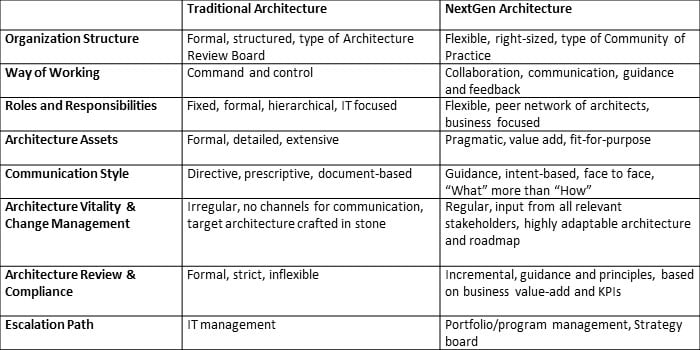NextGen Architecture in the Digital Age has been saved

Article
NextGen Architecture in the Digital Age
Architecture Awakens
During the last years, the agile way of working has become the norm within organizations competing in the digital era. At the same time, architecture has been sometimes perceived as complex, slow, legacy, non-agile and irrelevant. However, complex digital transformations of organizations nowadays show us that a modern, pragmatic architecture practice plays a crucial role in balancing risk and agility, managing complexity and achieving success.
Go directly to
- Agile at scale
- 'NextGen' agile architecture
- Traditional versus 'NextGen'
- Lessons learned from practice
- contact
Agile at scale
The agile way of working has created a positive impact on efficiency, structure, culture, internal processes, communication and decision-making within organizations. However, agile is not a silver bullet to solve all organizational IT and business issues. Some pitfalls of agile followed strictly have become obvious in practice: challenges in managing complexity, lack of context and big picture, disconnect between business goals and their realization, an increased risk of inconsistencies and siloed, spaghetti-style solutions. To overcome these issues, scaled agile frameworks have been proposed and increasingly used, with SAFe (Scaled Agile Framework) as the most prominent one.
'NextGen' agile architecture
Although the scaled agile frameworks introduce a certain level of architecture and governance in an agile way of working, they do not resolve all pitfalls mentioned. The complexity and dynamicity of modern business/IT environments in the digital era require a right balance of discipline, architecture thinking, risk and agility. Therefore, a modern, pragmatic and agile architecture method is required to translate business strategy into realization. By applying such method, the architecture function becomes more strategically important than ever. ‘NextGen’ agile architecture needs to be built on the solid architecture-thinking foundation with priorities on the following:
- Employ just in time and just enough architecture design and governance
- Work in a highly iterative and incremental manner
- Communicate business/architecture intent focusing on Why and What, but not How
- Act across the enterprise and beyond across the ecosystem(s)
- Become driven and measured by business outcomes and KPIs
- Facilitate frequent interactions among all (end-to-end) stakeholders
- Be flexible and evolvable to “survive”
- Keep it simple, pragmatic and realizable
- Always start with a Minimum Viable Architecture (MVA), as the minimal piece of the Architecture that is realizable and add business value
Further, the ‘NextGen’ architecture way of working should include:
- Integration of the Architecture governance with other organization’s processes
- Participation in Strategy boards and Portfolio Management and sharing of strategy/business intent to the rest of the organization downstream
- Frequent communication with all the stakeholders to gain trust, share vision and get support
- Organizing an Architecture Community of Practice for sharing knowledge and best practice, providing guidance and process the feedback from business and IT to adapt and refine target state and roadmap
- Balancing orchestration and choreography communication and working styles in dealing with agile delivery teams and architecture peers
- Creation of architecture assets to share, guide, get feedback and adjust and not to prescribe, dictate, create overhead and unnecessary complexity, and waste of time/talent
Traditional versus ‘NextGen’
The table below shows how Architecture evolves to play a key role in organization’s digital transformation journey.
Lessons learned from practice
Combining the ‘NextGen’ architecture and agile way of working in customer organization and project settings is not an easy and straightforward task. Here are some of the lessons learned from our recent customer projects:
- No single approach fits all – therefore, fine-tune it towards the fit the purpose
- Frameworks and methods are to tailor – they are by no means prescriptive and set in stone
- In a complex transformation environment, always go with a bit more architecture to tame complexity and mitigate risk of failure
- Invest in knowledge and expertise of people – architects trained in scaled agile and agile engineers trained in architecture thinking
- Be pragmatic, not dogmatic
Deloitte’s Technology, Strategy & Architecture practice often helps organizations making the transition into an architecture-supported agile organization. If you want to learn more on this, please contact one of the authors of this article.
More information?
For more information please contact Eric Onderdelinden or Erik Hegeman via the contact details below. Interested to read more? Register to receive the Tech Trends Report 2020 and updates on the trends via the blue button on the right!
More information?
For more information please contact Eric Onderdelinden or Erik Hegeman via the contact details below. Interested to read more? Register to receive the Tech Trends Report 2020 and updates on the trends via the blue button on the right!



